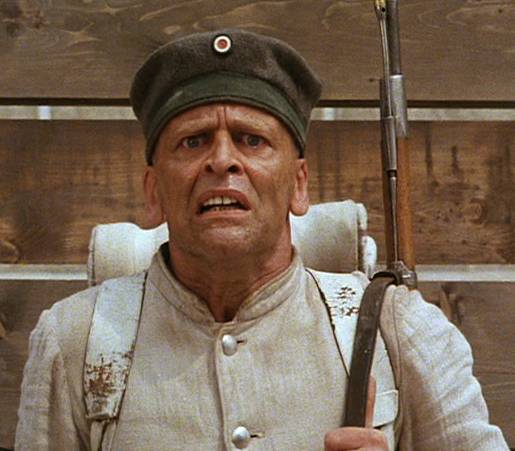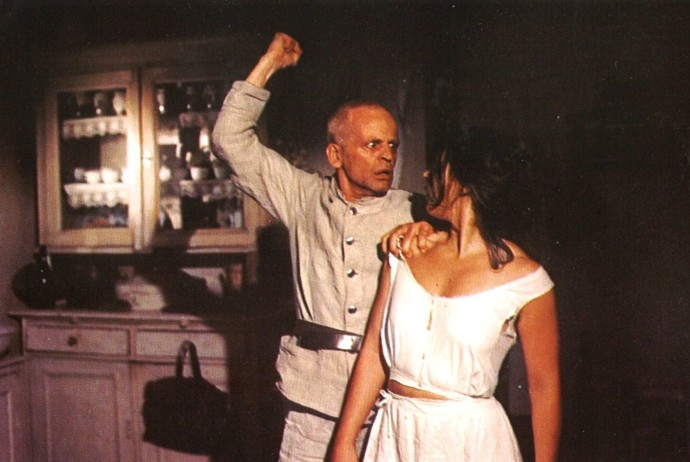Dir: Werner Herzog
Star: Klaus Kinski, Eva Mattes, Wolfgang Reichmann, Willy Semmelrogge
Filming on this started a mere five days after the completion of principal photography on Nosferatu, with most of the same crew, but the stylistic approach – there are a lot of long scenes, shot in a single take – allowed it to be finished in 18 days. Herzog had originally planned to use Bruno S, the star of Herzog’s earlier The Enigma of Kaspar Hauser, in the title role, but changed his mind and switched to Kinski. It’s based on a stage play by Georg Buchner, who left the work incomplete at his death – its resulting open-ended state has led to a number of playwrights and film-makers taking it on.
The central character is a soldier, who is already skating on mentally thin ice as we first see him, shaving his superior officer (Reichmann) with a cut-throat razor, and musing on the nature of life – not unlike Alfred Doolittle in My Fair Lady, Woyzeck claims morality is a luxury, not available to the poor like him. To make ends meet, so he can live with his common-law wife, Marie, (Mattes) and their young child, he also volunteers as human guinea-pig in the dubious experiments of a local doctor (Semmelrogge). These include living on nothing but peas for months at an end, a diet which isn’t exactly helping Woyzeck’s stability, who is hearing voices from the ground. Never a good sign…
 The tipping-point, however, is the realization that Marie may be having an affair with another soldier, higher in rank and – let’s be honest – physical appeal, charm and sanity, while he’s at it. This sends Woyzeck right over the edge, and he stabs her to death while they’re out on a walk. He takes refuge in a local inn, though his blood-stained appearance gives him away. The film ends with the discovery of Marie’s body, and a final caption, stating that it’s been some time since they’ve had such a good murder. I suppose this is some kind of spoiler, but it’s in such little doubt that this is where the movie is heading, that it barely counts.
The tipping-point, however, is the realization that Marie may be having an affair with another soldier, higher in rank and – let’s be honest – physical appeal, charm and sanity, while he’s at it. This sends Woyzeck right over the edge, and he stabs her to death while they’re out on a walk. He takes refuge in a local inn, though his blood-stained appearance gives him away. The film ends with the discovery of Marie’s body, and a final caption, stating that it’s been some time since they’ve had such a good murder. I suppose this is some kind of spoiler, but it’s in such little doubt that this is where the movie is heading, that it barely counts.
There are some things that are more fun to experience directly, than watch someone else do. Play video games is one; take drugs another (as The Trip shows – one of only a few movies I’ve ever walked out on). Go insane is probably in the same category, going by this, which consists of not much more than 80 minutes of Kinski pulling faces and burbling absurdist nonsense – the rest of the cast shares more in the latter than the former – witness the story Marie tells to the local children, for example. But how much of this is Herzog, and how much Buchner, remains uncertain. The origins on the stage are certainly extremely obvious, with Herzog apparently yelling “Action!”, then wandering off for a coffee – or, indeed, going by the length of some takes, dinner and a show.
Occasionally, this does work magnificently: the final killing is up there with Psycho, in terms of being horrific without showing anything to speak of. Its impact is mostly due to the single shot, languidly approaching three minutes, of Woyzeck’s face as this tortured soul realizes that he has just killed the only person apparently capable of loving him to any degree. But the overall results are well on the mediocre side: it’s never made clear what exactly Herzog is trying to say. Is Woyzeck the helpless victim of a callous and class-ridden society? [The play generally appears to lend itself to a fairly Marxist reading] Or is this simply a glimpse into the tormented mind of someone who is only marginally functioning, in a 19th-century version of ‘care in the community’? There’s just not enough of a compelling narrative to make this more than occasionally interesting.

